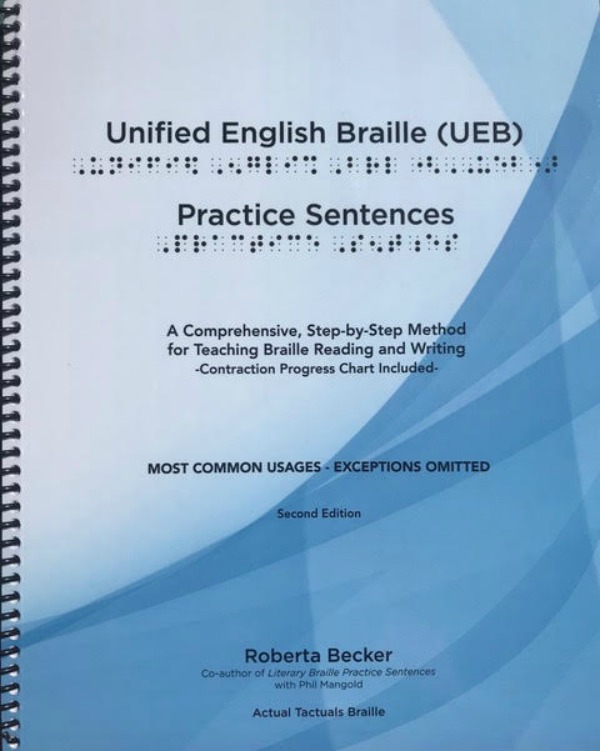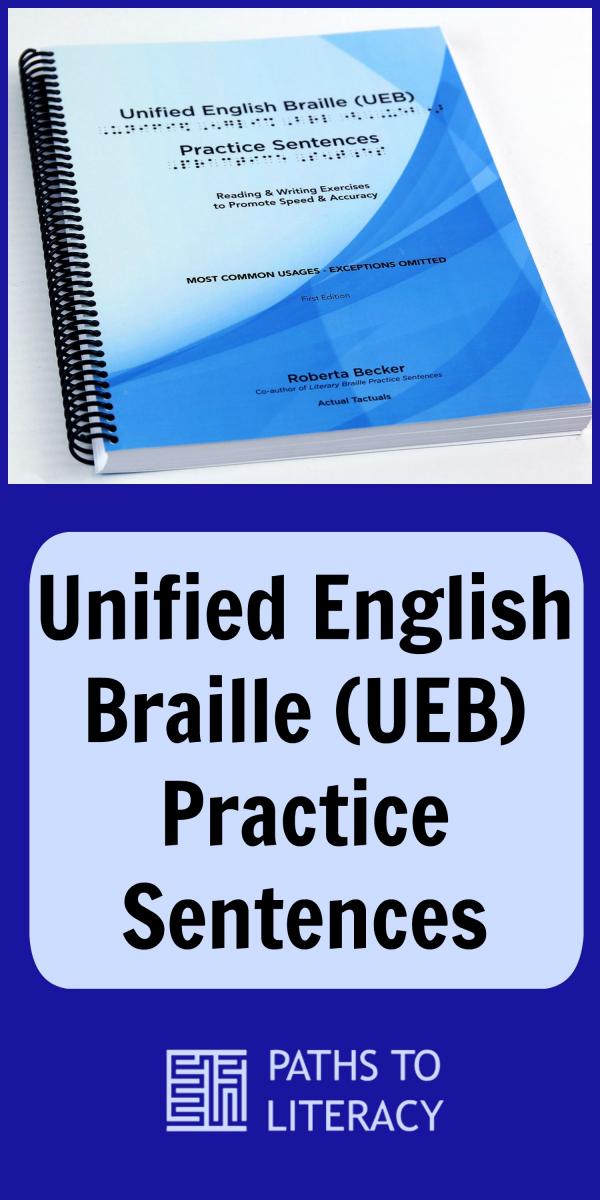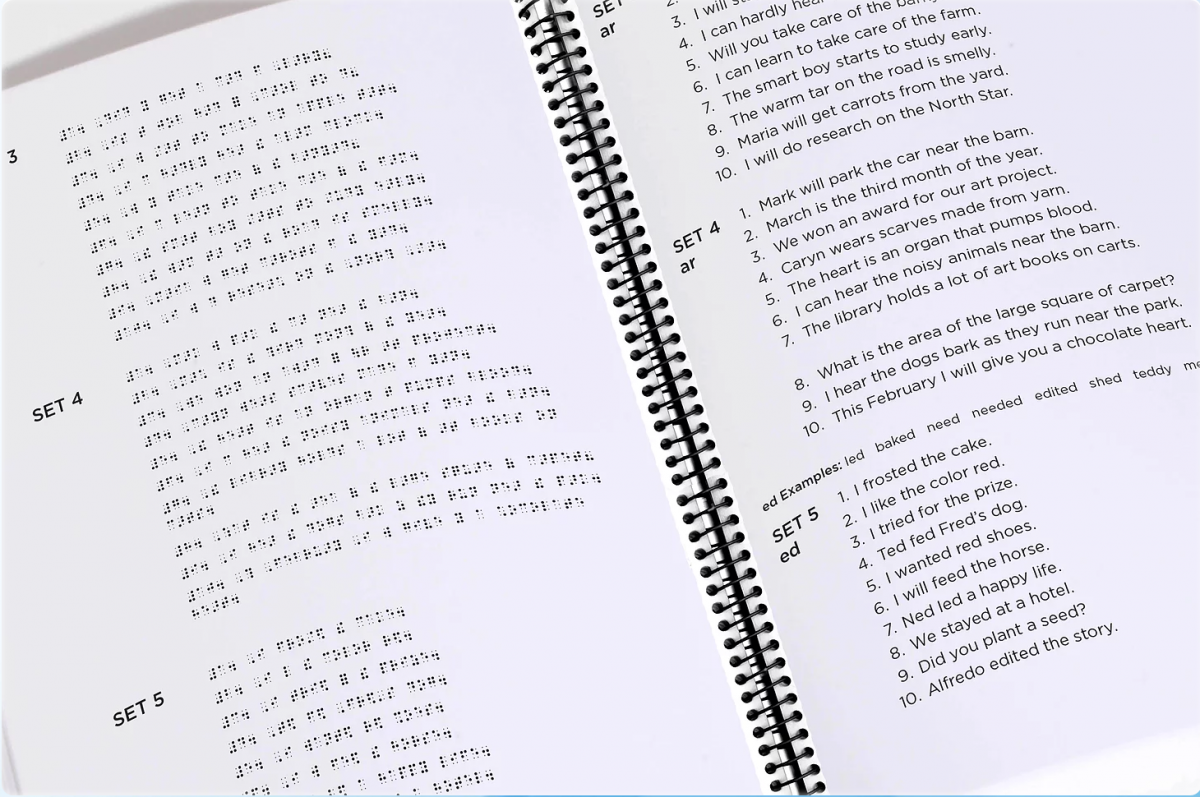
UEB Practice Sentences – Second Edition
UEB Practice Sentences can be used to teach braille students contractions.
Are you looking for ways to easily and systematically teach the Unified English Braille (UEB) contractions to students of ALL AGES? If so, this book (2019) by Roberta Becker may be just what you’re looking for. Unified English Braille (UEB) Practice Sentences, Second Edition, provides comprehensive practice sentences for each braille contraction, set up in a sequential, easy-to-learn format. It also contains many of the more commonly used punctuation and symbols.
This book is being used successfully in public and private schools, Schools for the Blind, universities, and by transcribers in the United States. It is also being used by schools in Canada, UK, Australia and New Zealand. If you are interested in shipment to other countries please contact ActualTactuals@gmail.com.
Features
- Available in both print and braille editions.
- Braille is available as single or double spaced.
- Good for ALL AGES-first grade thru high school, and beyond.
- Problematic contractions can be isolated for additional reading/writing practice.
- Can easily be used in performing assessments, and writing IEP goals and objectives.
Contents
- All UEB contractions are included.
- Also included are lessons on commonly used UEB symbols: punctuation, mathematical symbols, typeface indicators, and internet addresses.
- Internet address lessons include actual working accessible websites.
- “Exceptions to the rules” have been omitted, allowing students to become secure with braille configurations and basic rules.
- Over 80 pages of print sentences, with matching pages in simulated braille.
- Includes suggestions on ways to use this book to enhance learning.
- Contractions Chart lists all contractions by type of contraction.
- Symbols Chart-symbols are arranged by the Lesson in which they are covered
- Symbols Chart II-symbols are arranged alphabetically by name of symbol.
- Contraction Progress Chart-to help you track your student’s growth.
Organization
- Progresses cumulatively through ALL of the braille contractions.
- Each lesson includes ONLY the contractions that have been PREVIOUSLY covered.
- Sentences in each Lesson progress from simple (shortest) to more complex (longest), so it can be used with students of any age. It is easy to pinpoint appropriate level exercises for individual students.
- Every contraction is introduced individually with practice sentences that give sufficient repetition for mastery. In most cases there are 10-40 practice sentences for each contraction.
- Some contractions (examples: ch, sh, th, wh, ou, and st) can be used as either Wordsigns or Groupsigns. Therefore, to avoid confusion and facilitate learning Wordsigns and Groupsigns are always introduced separately.
- As shown in the photo below, the simulated braille sentences are found on the left page of the book, with the print on the facing right page. This allows parents and students’ aids to easily check classwork or homework assignments, even if they do not know braille.
- The simulated braille is very helpful for people who are becoming transcribers.
Braille Edition
- The entire braille book is ready to use. No embossing necessary.
- Available in either single or double-spaced braille.
- The Double-Spaced Braille Student’s Edition makes it easier for students who are new to braille reading (any age) to track and to read. It reduces confusion caused by accidentally touching the lines above or below, and it instills confidence when reading.
-
The braille Student’s Edition provides an opportunity for students to:
- get practice in reading the sentences
- check their own answers independently
-
The braille version allows older students to work independently on:
- Keyboarding
- Spelling out the contractions
- Developing word processing skills using speech software
- Using computers with refreshable braille display.
These books are an excellent introduction to learning to read/write the braille contractions. It is easy to find specific lessons which address contractions that are problematic. By using the “Contraction Progress Chart” you will have a quick and easy way to track your student’s growth. It is useful for additional types of lessons, as mentioned above. It can also be used for assessment and developing IEPs. You will find that it is useful at any grade level.
If you have any questions about this book, please contact Roberta Becker at ActualTactuals@gmail.com.


